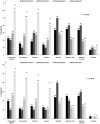Functional heartburn has more in common with functional dyspepsia than with non-erosive reflux disease
- PMID: 19460766
- PMCID: PMC2719081
- DOI: 10.1136/gut.2008.175810
Functional heartburn has more in common with functional dyspepsia than with non-erosive reflux disease
Abstract
Introduction: Functional dyspepsia and non-erosive reflux disease (NERD) are prevalent gastrointestinal conditions with accumulating evidence regarding an overlap between the two. Still, patients with NERD represent a very heterogeneous group and limited data on dyspeptic symptoms in various subgroups of NERD are available.
Aim: To evaluate the prevalence of dyspeptic symptoms in patients with NERD subclassified by using 24 h impedance-pH monitoring (MII-pH).
Methods: Patients with typical reflux symptoms and normal endoscopy underwent impedance-pH monitoring off proton pump inhibitor treatment. Oesophageal acid exposure time (AET), type of acid and non-acid reflux episodes, and symptom association probability (SAP) were calculated. A validated dyspepsia questionnaire was used to quantify dyspeptic symptoms prior to reflux monitoring.
Results: Of 200 patients with NERD (105 female; median age, 48 years), 81 (41%) had an abnormal oesophageal AET (NERD pH-POS), 65 (32%) had normal oesophageal AET and positive SAP for acid and/or non-acid reflux (hypersensitive oesophagus), and 54 (27%) had normal oesophageal AET and negative SAP (functional heartburn). Patients with functional heartburn had more frequent (p<0.01) postprandial fullness, bloating, early satiety and nausea compared to patients with NERD pH-POS and hypersensitive oesophagus.
Conclusion: The increased prevalence of dyspeptic symptoms in patients with functional heartburn reinforces the concept that functional gastrointestinal disorders extend beyond the boundaries suggested by the anatomical location of symptoms. This should be regarded as a further argument to test patients with symptoms of gastro-oesophageal reflux disease in order to separate patients with functional heartburn from patients with NERD in whom symptoms are associated with gastro-oesophageal reflux.
Conflict of interest statement
Figures



References
-
- Kahrilas PJ. Gastroesophageal reflux disease. JAMA 1996;276:983–8 - PubMed
-
- Spechler SJ. Epidemiology and natural history of gastroesophageal reflux disease. Digestion 1992;51(Suppl 1):24–9 - PubMed
-
- Smout AJPM. Endoscopy-negative acid reflux disease. Aliment Pharmacol Ther 1997;11(Suppl 2):81–5
-
- Lind T, Havelund T, Carlsson R, et al. Heartburn without esophagitis: efficacy of omeprazole therapy and features determining therapeutic response. Scand J Gastroenterol 1997;32:974–9 - PubMed
-
- Fass R, Fennerty MB, Vakil N. Non-erosive reflux disease (NERD) – current concepts and dilemmas. Am J Gastroenterol 2001;96:303–14 - PubMed
Publication types
MeSH terms
LinkOut - more resources
Full Text Sources
Other Literature Sources
Medical
Miscellaneous
